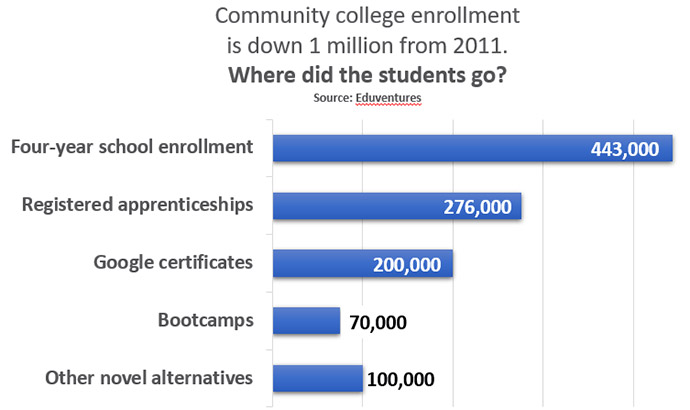
2021 Chancellor's Annual Report
Introductory Letter
For most of the 20th century, music lovers seeking a recording of their favorite song usually had to buy the entire album on which the song appeared.
That distribution model began to change at the turn of the century and was profoundly disrupted by the rise of the Four Superpowers. Broadband internet and mobile technology enabled the rise of streaming music services such as Spotify, Tidal, YouTube, Apple Music and Amazon, which allow customers to precisely choose the songs they want to buy. Empowered consumers maintain the locus of control; in fact, thanks to smartphones, it is literally in the palm of their hands.
I believe higher education faces a similar transformation. Like musicians writing and recording songs, faculty create courses that colleges and universities have long curated, combined and packaged into certificates and degrees, much like music companies produced vinyl albums. But this approach is increasingly out of tune for many of today’s consumers of education, especially adult working learners seeking a family-sustaining wage in a pandemic-battered economy.
Increasingly, learners favor short-term, nondegree skills training over traditional certificates and degrees. And again, thanks to broadband and mobile technologies, multiple competitors – Coursera, Udemy and Google, to name a few – are providing a catalog of online education options from which learners can pick and choose, essentially creating a personalized playlist that fits their specific academic needs.

To thrive, Pima Community College must recognize and leverage this transformation. The ongoing decline in birth rates has been well-documented and has real consequences for higher education. Moreover, as the chart above indicates, learners are choosing a variety of alternatives to community colleges. Some are seeking degrees from bachelor's degree-granting institutions. Many are employed, albeit in low-wage jobs, and are balancing work and family responsibilities. Many have attended college but have not earned a traditional degree or certificate. They are looking for – and finding – something different.
PimaFastTrack
Our new micropathways initiative, which we are branding as PimaFastTrack, is a different way to deliver education. As a participant in Education Design Lab’s Community College Growth Engine Fund, we are among a handful community colleges pioneering short-term, non-credit coursework provides the skills to succeed in a variety of Career and Technical Education occupations:
- Automated Industrial Technology
- Automotive Technology
- Building and Construction Technologies (Carpentry, Electrical, HVAC, Plumbing)
- Cybersecurity/IT
- Emergency Medical Technology
This coursework is offered as non-credit to give the learner as much access as possible. Most PimaFastTrack courses are taught through the hybrid in-person + online format. All but the Cyber/IT micropathway can be completed in three months. Thanks to our Prior Learning Assessment initiative, learners who complete their program will have a head start should they continue on to a traditional certificate or degree.
Expanding Access
PimaFastTrack is an innovative on-ramp to higher education for learners, many of whom are poor and-or belong to Communities of Color, who have been historically underserved by traditional higher education. They collapse the either-or distinction between credit and non-credit learning, replacing it with a both-and approach that learners believe benefits them in the workplace.
As I have said, Pima can be an instrument of social justice by expanding access to higher education to everyone. Through initiatives such as PimaFastTrack, we can give everyone the opportunity to achieve economic equity through a career that pays a family-sustaining wage. In these uncertain times, it’s all about good jobs.